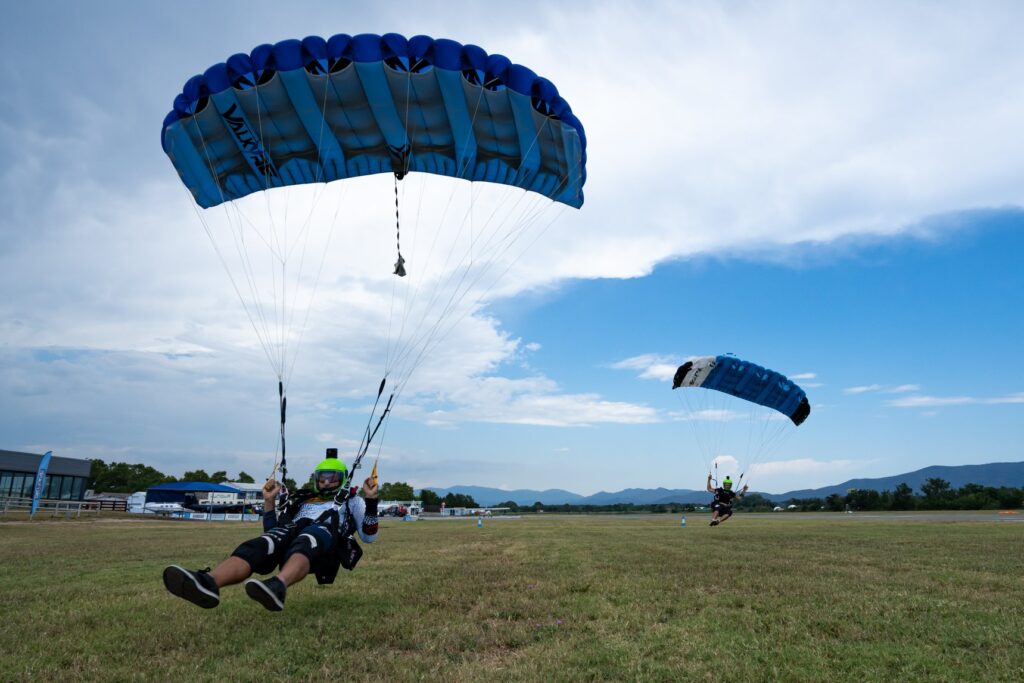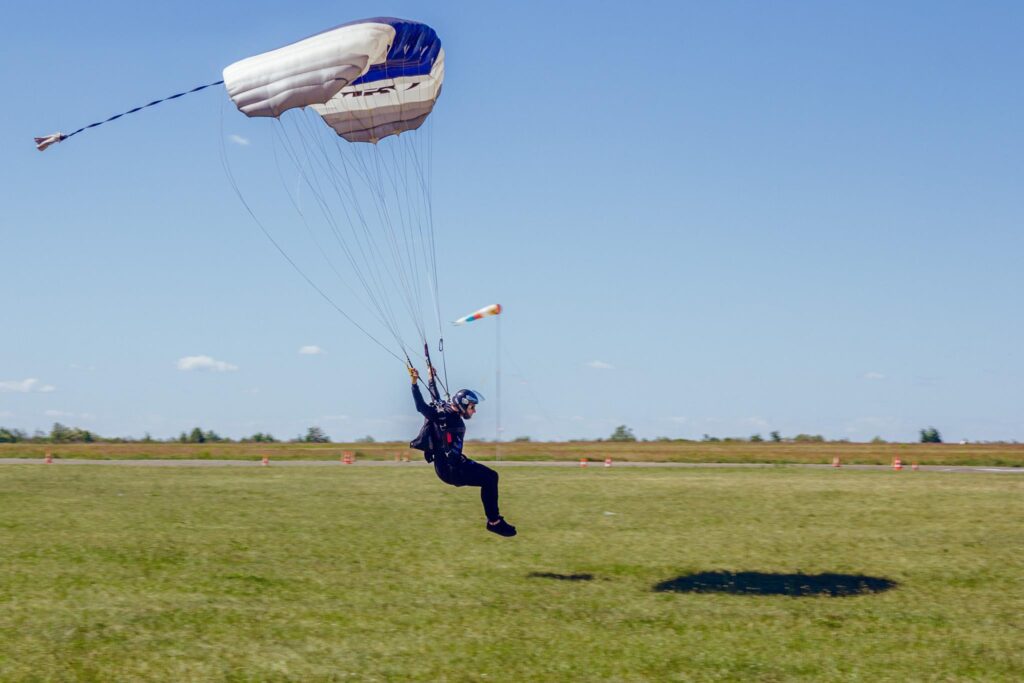Don’t you just love it when you have a perfect 5-8 knot headwind!

Photo by Skydive Empuriabrava
It’s when we manage to slow our parachute down to zero and set ourselves down as light as a feather. Unfortunately we don’t always have those perfect conditions, and more often than we’d like we find ourselves dealing with high head-winds, very fast nil wind landings or even worse, we have to run out the occasional scary fast downwinder.
The most difficult and scary part is trying to figure out how high and fast to flare in all these different conditions… right?
What if I told you that:
the secret to consistent landings in all conditions is to NOT change your flare technique, regardless of wind strength or direction?
The reasons are two simple truths:
- Airspeed is not the same as Ground speed.
- Airspeed is proportionate to lift.
In this article we will learn the meaning and implications of the following two rules:
- The speed at which you fly over the ground has very little to do with how much potential energy for the flare is in your parachute.
- The potential for a powerful flare depends on the Airspeed your wing has in that given moment.
Let me clarify the difference between Airspeed and Ground Speed.

Airspeed (AS)
Airspeed (AS) is the forward speed of your wing which generates airflow around the airfoil, regardless of atmospheric wind. It is influenced by:
- Canopy size
- Canopy design
- Wing loading
- Flight mode (pilot input)
- Flight cycles (aftermath of the pilot input in the Wing)
- Drag
- Other minor factors
Airspeed (AS) = Potential flare power
It is best maximised by letting the parachute fly without input for 10 seconds before the flare.
Ground speed (GS)
Ground speed (GS) is the speed at which you cover distance over the ground. It is calculated by adding Wind Speed (WS) to your AS in case of a tailwind, or subtracting WS in case of a headwind.
Here are three examples to clarify the difference between Airspeed (AS), Ground Speed (GS) and the role of Wind Speed (WS):

Imagine you are walking at the airport next to your friend. You both walk at exactly the same speed of 4mph. This is as if you were flying your parachutes in no wind. Your AS and GS are matching because of the complete absence of atmospheric wind.
Your Airspeed and Ground Speed are only equal in the complete absence of atmospheric wind”

Now imagine your friend steps onto a horizontal walkway that moves at 3 mph (WS) and you see him move away from you. You both keep walking at the exact same speed (4mph), yet he covers more ground than you because of the added speed of the walkway.
This is what happens with your Airspeed (AS) and Groundspeed (GS) when you fly your canopy in no wind vs. tailwind.

Let’s imagine then that your friend steps onto a horizontal walkway that moves in the opposite direction moving at 3mph and you leave your friend behind. Again, you both keep walking at the exact same speed (4mph), yet you cover more ground than him because he has the walkway working against him. It is as if he is flying into a headwind.
It is important to remember:
- Airspeed is potential flare power
- In all examples, Airspeed remains constant for Person A and B
- Ground Speed might change with varying wind direction and strength

Photo by Oksana Oriekhovska
Effects
Here is how that might affect us in a real life situation:
In zero winds our parachute seems like it flies scarily fast over the ground before landing.
Actually, we are witnessing the true Airspeed of the wing, since the AS now matches the Groundspeed, GS. In this situation it is very common to want to reduce the forward speed by applying a bit of brake due to fear of a crash landing.
By applying brakes before it’s time to flare, we reduce our airspeed and kill our potential flare power”
By applying brakes to slow down before it is time to flare, we actually reduce our AS and kill our potential flare power, so we cause ourselves a harder landing than necessary. This then augments the fear of no-wind landings and becomes a Catch 22 situation.
In this Article we have discovered that our Groundspeed is a result of wind conditions. Airspeed, which is our potential flare power, is independent of Groundspeed. Therefore, our flare height and technique are independent of the wind conditions and do not need to change in varying conditions.
Flare power is independent of wind speed or direction”

Photo: Julian landing by Roy Wimmer Jaglom
Tips for softer landings
Here are some practical tips to have softer landings in all wind conditions:
- Let your parachute fly 10 seconds without input before flaring, regardless of wind conditions.
- Keep your flare height and technique the same in all conditions, unless you hit turbulence during the flare.
- Keep looking forward during your flare, until you touch down.
- Finish your flare symmetrically.

Photo: Julian Barthel by Roy Wimmer Jaglom
Subscribe to FlyInMynd
Receive exclusive content about Safety & Education by Julian Barthel. Click here to JOIN NOW.




